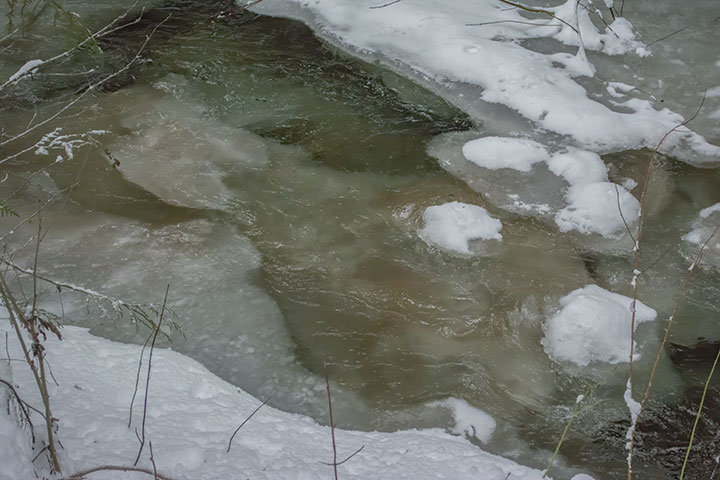A dipper sometimes forages under ice.
I believe I know when and why it does so.
The odd thing about this, is that I have often watched a dipper stand on the border ice along a creek, dive into the open waters in the middle, retrieve something, and bring it back to the ice to eat. But, I had never seen one dive into the water and then turn to forage under the ice it had been standing upon. Why would a dipper do this?
The insight for me started last November when Liv Grant wrote me about dippers in connection with a nature film, “it is quite surprising to see a bird which is not a penguin swimming under ice!” I responded that I had never seen a dipper do this. Then four days ago, I posted about a Common Goldeneye foraging under ice and mentioned the problem with dippers. Two observers, Derek Kite and Bob Stubbs, then wrote me separately to say they had seen a dipper forage under ice. Superb. But, what occasioned the difference between the dipper’s behaviour during their observations and my own earlier ones?
We have now had a succession of days with temperatures of between -15 °C and -10 °C. Local creeks are icy, so yesterday, I went dipper watching. This time, the dipper was seen repeatedly foraging under border ice and I realized when and why they do so.
First, there is a discussion of the dipper’s behaviour, and then an explanation of it.
A dipper stands on border ice and is about to swallow an aquatic arthropod that it had retrieved from the bottom of the creek.

The dipper stands on the edge of the border ice about to dive.

It would then dive in, but promptly turn and swim under the border ice it had been on.

Finding something under the ice, the dipper brings it to the surface and eats it. It looks rather like a caddisfly larva.

The dipper did this over and over (for as long as I was willing to watch it). Here it can be seen swimming under some really thin ice. Once I saw it travel at least two metres under the ice. It almost always found something worth retrieving and eating.

The dipper doesn’t usually forage under ice. The clue to when it does so is that there has been a succession of days with temperatures below about -10 °C, which festoons the creek with ice. Yet, this doesn’t answer the question of why it forages under ice only sometimes when there is ice. The answer to why lies with the two forms of ice found along a turbulent mountain stream. Border ice, which lies atop the water, forms along the gently flowing creek sides. Anchor ice, which lies on the base of the creek, forms in the turbulent central channel. (See a discussion of how these form.) The dipper acquires most of its eatables along the base of the creek, and the central portion of this is now covered by anchor ice. However, under the border ice, the creek’s base is clear so the hunting is good. The dipper now forages where it can find food, that is, under the border ice. In this earlier picture, the border ice is on the lower left and upper right, while the anchor ice is the yellowish material in the centre.


Thanks, Alistair, for giving us more to notice when we’re out and about along a stream or the Kaslo River!
Thanks Alistair, I don’t respond often from my location out in Victoria area, but I really appreciate the things that I learn about observing and understanding the things we so often just “see”.
So great you figured it out – the photos are absolutely amazing. I guess if I went down to the river I’d see this phenomenon too, but damn it’s cold out, (-20 as I write) – and even with all the sun in the day, it barely reaches the river valley. I got some frostbite on my cheeks down there a few years ago, and I still have a little white circle on each cheek. I’ll have to watch for the precise moment when the days warm up, but the ice hasn’t changed. Thankfully, a flock of siskins and a handful of red crossbills came together and ate gravel on the edge of the carport yesterday. They didn’t go near the feeder tho.
In a somewhat similar vein, prolonged cold weather sometimes causes Dippers to visit our pond, where they swim about in a small patch of open water maintained by an up-welling spring. Now I know why.